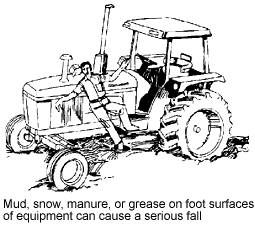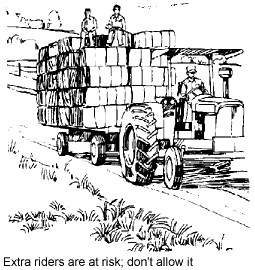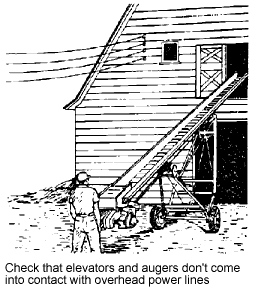 All the steps involved in growing, harvesting and storing
grain crops require using equipment that has the potential
to injure a farmer who fails to follow safe operating practices.
There are several safety rules that can be applied to the
planting, harvesting, transporting, drying, and storing procedures.
All the steps involved in growing, harvesting and storing
grain crops require using equipment that has the potential
to injure a farmer who fails to follow safe operating practices.
There are several safety rules that can be applied to the
planting, harvesting, transporting, drying, and storing procedures.
Avoid
operator fatigue - take frequent short rest breaks if
necessary. Don't take unnecessary chances when trying to complete
a job in a hurry.
Plan
ahead - maintain machinery on a regular basis. Check equipment
before it is used.
Stop
- if equipment becomes plugged or needs to be checked, make
sure that all moving parts have stopped and that no one else
can start the equipment while it is being checked, cleaned,
or repaired. Use "lock-out" procedures when necessary.
Look
- keep your eyes open and stay alert. Watch for problems.
Listen
- be sure you can hear what is happening. Wear ear protection
when operating equipment or working around machinery.
Follow
safe operating procedures - become familiar with owner/operator
manuals for all equipment that will be used. Refer to the
manual for adjustment and repair information. Make certain
that other workers use safe operating procedures.
Keep
guards and shields in place - if guards and shields are
removed for maintenance or repair be sure to replace them
BEFORE the equipment is operated again.
Keep
steps and walking surfaces clean - watch for mud, ice,
grease, and oil. Use handrails where provided.
Dress
appropriately - wear reasonably snug fitting clothing
without torn or frayed edges. Avoid jackets and sweat shirts
with draw strings, which may get tangled in moving equipment.
Wear
protective clothing and gear - goggles, gloves, dust masks,
ear plugs, etc. should be worn whenever necessary, not just
when it is convenient.
Be
alert for children - curious children must be kept away
from all equipment. Because they are smaller than adults it's
more difficult to see them when operating equipment. Keep
them away from farm operations until they are old enough to
safely handle any task assigned.
Grain planting and harvesting equipment should be lubricated and maintained on a regular basis. Refer to the owner's manuals when maintenance or repairs are necessary.
- Never
service equipment while it is running unless the service
manual indicates that operating the machinery is necessary
to perform the maintenance or repairs.
- Proper
field preparation is essential to safety. "Clean" fields
before planting or harvesting by removing stones, low branches
and other debris that may damage equipment or injure workers.
Mark obstacles that might be difficult to see when sitting
in the equipment operator's seat. Be alert to changing soil
conditions; excessive rainfall or heavy rains may cause
gullies or "wash outs". In dry conditions ditch embankments
may give way under the weight of equipment.
- Check
tires for proper inflation and soundness.
- If
you are driving a machine, communicate with other workers,
especially when attaching implements.
- When
equipment must be adjusted or serviced in the field, shut
down and use lock-out procedures to assure yourself that
no one else can start the equipment. Allow sufficient time
for moving parts (i.e. the flywheel on a bailer) to stop
before servicing.
- Keep
hands out of pinch points. Numerous Michigan farmers have
lost their hands while trying to free jammed chains, belts,
etc. when harvesting grain. Harvesting equipment uses moving
parts to remove grain from the plant; when jammed, the machine's
movement is stopped, but there may be pressure on the grain
or stalk that caused the jam. Once the jam is removed the
machine often tends to "lurch" forward, pinching fingers,
hands or anything else in its path. Don't put your hands
in jeopardy.
- Block
the wheels on moving parts to keep them from moving suddenly.
- Tractors
and combines accept various implements. Be aware that these
implements will cause the tractor or combine to handle or
operate differently. Check for secure connections before
operating an implement; use locking hitchpins and safety
chains.
- During
harvesting, stay out of trucks and wagons when grain is
being loaded or unloaded. Suffocation can occur when a person
is trapped in flowing grain.

Most agricultural equipment has only one seat for the operator;
extra riders are at risk and should not be allowed to ride on
any agricultural tractor. Use appropriate safety equipment provided,
such as seat belts or harnesses and handrails or foot rests.
- When
operating equipment on the public roads, check to see that
slow moving vehicle signs are securely attached, clearly
visible and that they are not faded.
- Obey
state and local highway and public roadway laws. Check lights
for visibility from the front and the rear. Check that tall
equipment will not contact overhead power lines. Be aware
that some equipment may require wide turns.
- Check
the owner's/operator's manuals to determine the best way
to position an implement for transport on public roads.
- Distribute
loads evenly and do not overload wagons. If there is a problem
in stopping when hauling loads of grain, it is usually the
result of the tractor being unable to stop in time with
the additional weight of the wagon. Under Michigan law,
only two wagons can be towed by an agricultural tractor;
a pickup truck is permitted to tow only one wagon.
Grain storage
systems have many parts, all of which require safety considerations.
Read and heed all safety signs and warnings on equipment and
follow manufacturers' instruction manuals.
- Grain
dryers are noisy and there is a potential for explosion
and/or fire. Be prepared. Have all workers wear hearing
protection when the grain dryer is operating. Keep an ABC
type (dry chemical) fire extinguisher near the control panel.
- Have
fire department and other emergency phone numbers readily
available.
- Be
sure that all workers and family members are familiar with
safety equipment and can contact emergency help. Teach younger
children how to contact help, especially if "911" service
is available in your area.
- Watch,
smell and check for gas leaks near a grain dryer. Hire a
professional for repairs to the burner or to the electronic
control system. A professional should also be hired to upgrade
or to install a new grain dryer system.
Storage
bins present a multitude of potential hazards. Mold and dust
are common health hazards that can cause respiratory damage.
Entrapment in grain flow can cause death from suffocation. Entrapment
happens very quickly and results in more deaths than injuries.
Falls
from a grain bin roof or ladder can result in serious injuries
or death.
Common
recommendations for grain bin safety include:
- Never
enter a bin where grain is flowing. Stop the flow and shut
off all automatic equipment and power.
- Use
lock-out procedures when making repairs or when entering
the bin for any type of inspection.
- Never
enter a grain bin alone. Always make sure someone knows
where you are. If possible, have two people available to
help; one can go for help while the other person helps you.
If you are helping, do not jeopardize yourself if you cannot
safely rescue the other person.
- Attach
ropes inside the bin and use a harness if you must walk
on the grain. Many farmers have died after falling through
a crust of spoiled grain and were buried in the loose grain
underneath the crust.
- Make
sure a storage bin is well ventilated before entering. Wear
a respirator to protect against dust and mold.
- If
trapped, but not buried, stay near the outside wall and
walk around the storage bin as the grain moves downward.
- Keep
ladders in good repair and free of slippery materials.
- Seek
professional help if servicing or repairing the electrical
or LP gas systems is necessary.
Many accidents
occur around augers and conveyors. Augers are used in the field
when loading and at the grain center when unloading. Use the
same precautions at both locations.
- Transport
an auger or conveyor in a lowered position.

- Adjustments
to an auger or conveyor should be done by two people. Watch
for overhead hazards such as power lines. Also be aware
of ground conditions that could upset the auger when it
is being moved or put into place.
- Check
hoist cables and replace when worn or frayed.
- Never
attempt to grab the spinning crank if the lift mechanism
breaks out of control.
- Block
the wheels and support the head of the auger or conveyor
when it is in operation.
- Never
go under an auger or elevator as it is being raised.
- Illustrations
courtesy of Deere & Company, Moline, Illinois, Agricultural
Safety, Fundamentals of Machine Operation series, 1987.
- Reviewed
- R.Brook, Agricultural Engineering, Michigan State University
Michigan State University,
Agricultural Engineering Department.
Howard J. Doss, Cornita Tilma, Agricultural Safety Specialist
and former Graduate research assistant, respectively, Michigan
State University Extension, East Lansing, Michigan 48824. 4/92.
Funded by the National Institute of Occupational Safety and
Health - #UO5/CC-4506052-01. This information is for educational
purposes only.
Disclaimer and Reproduction Information: Information in
NASD does not represent NIOSH policy. Information included in
NASD appears by permission of the author and/or copyright holder.
More
 All the steps involved in growing, harvesting and storing
grain crops require using equipment that has the potential
to injure a farmer who fails to follow safe operating practices.
There are several safety rules that can be applied to the
planting, harvesting, transporting, drying, and storing procedures.
All the steps involved in growing, harvesting and storing
grain crops require using equipment that has the potential
to injure a farmer who fails to follow safe operating practices.
There are several safety rules that can be applied to the
planting, harvesting, transporting, drying, and storing procedures.
 Most agricultural equipment has only one seat for the operator;
extra riders are at risk and should not be allowed to ride on
any agricultural tractor. Use appropriate safety equipment provided,
such as seat belts or harnesses and handrails or foot rests.
Most agricultural equipment has only one seat for the operator;
extra riders are at risk and should not be allowed to ride on
any agricultural tractor. Use appropriate safety equipment provided,
such as seat belts or harnesses and handrails or foot rests.
